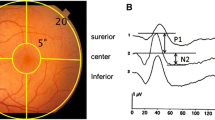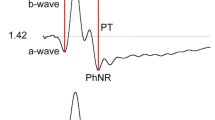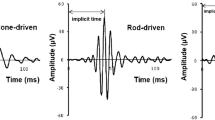Abstract
Of all the electroretinogram (ERG) components (a-wave, b-wave, and oscillatory potentials) only one oscillatory potential, OP2, was found to be significantly correlated with the absolute intensity of the flash stimulus (i.e., the intensity of the stimulus irrespective of the state of retinal adaptation). Our finding was further confirmed in single cell recordings of lateral geniculate unit activity in rabbits in which peak time of OP2 was found to correlate better with the geniculate activity. For these reasons we have identified OP2 as the “intensity coding” oscillatory potential of the ERG. In order to investigate if this new feature could have some clinical significance, we examined photopic ERGs recorded from patients affected with various retinopathies. In most instances the peak time of OP2 paralleled that of the b-wave, that is, in the ERG with delayed b-wave the peak time of OP2 was also delayed, while in ERGs with normal b-wave peak time the peak time of OP2 was also normal. However, in some conditions (especially in cone-rod diseases) a delayed OP2 was found in ERGs with normal b-wave peak times.
Similar content being viewed by others
References
Lachapelle P, Molotchnikoff S. Components of the electroretinogram: a reappraisal. Doc Ophthalmol 1986; 63: 337–48.
Lachapelle P, Little JM, Polomeno RC. The photopic electroretinogram in congenital stationary night blindness with myopia. Invest Ophthalmol Vis Sci 1983; 24: 442–50.
Lachapelle P. Analysis of the photopic electroretinogram recorded before and after dark adaptation. Can J Ophthalmol 1987; 22: 354–61.
Benoit J, Lachapelle P, Cheema D, Faubert J, Molotchnikoff S.. Temporal relationships between ERG components and geniculate unit activity. Invest Ophthalmol Vis Sci 1988; 29 (suppl): 295.
Gouras P, MacKay CJ, Ivert L, Mittl RN, Neuwirth J, Eggers H. Computer-assisted spectral electroretinography in vitrectomy patients. Ophthalmology 1985; 92: 83–90.
Sawyer CH, Everett JW, Green JW. The rabbit diencephalon in stereotaxic coordinates. J Comp Neurol 1954; 101: 801–24.
Peachey NS, Alexander KR, Fishman GA. Rod and cone contributions to oscillatory potentials: an explanation for the conditioning flash effect. Vision Res 1987; 27: 859–66.
MolotchnikofF S, Lachapelle P. Lateral geniculate cell responses to electrical stimulation of the retina. Brain Res 1978; 152: 81–95.
Molotchnikoff S, Lachapelle P. Evidence for a collicular input to the dorsal lateral geniculate nucleus in rabbits - electrophysiology. Exp Brain Res 1980; 40: 221–8.
Molotchnikoff S, Lachapelle P. Local excitability in the superior colliculus influences evoked responses of lateral geniculate cells in rabbits. Brain Res Bull 1983; 11: 533–45.
Berson EL, Gouras P, Hoff M. Temporal aspects of the electroretinogram. Arch Ophthalmol 1969; 81: 207–14.
Berson EL, Howard J. Temporal aspects of the electroretinogram in sector retinitis pigmentosa. Arch Ophthalmol 1971; 86: 653–65.
Brunette JR. Clinical electroretinography. Part 2: applications. Can J Ophthalmol 1982; 17: 239–44.
Author information
Authors and Affiliations
Rights and permissions
About this article
Cite this article
Lachapelle, P., Benoit, J., Little, J.M. et al. The diagnostic use of the second oscillatory potential in clinical electroretinography. Doc Ophthalmol 73, 327–336 (1989). https://doi.org/10.1007/BF00154488
Received:
Accepted:
Issue Date:
DOI: https://doi.org/10.1007/BF00154488




